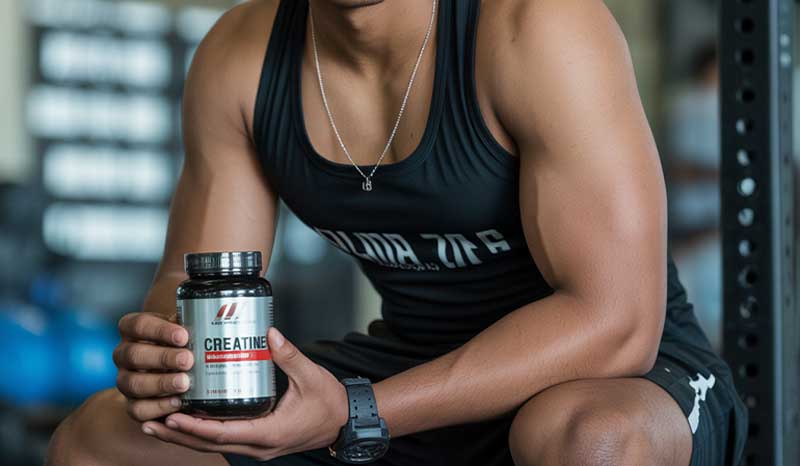Can a 17-Year-Old Take Creatine? Safety Explained
Creatine - In today’s fitness-driven world, many Indian teenagers are hitting the gym, following workout influencers, and taking their health seriously at a young age.
With fitness supplements like creatine being marketed everywhere from Instagram to gym trainers, the question naturally arises: Can a 17-year-old take creatine?
What is Creatine and How Does It Work?
Before we discuss whether a 17-year-old can or should take creatine, it’s essential to understand what creatine is and how it works in the body.
Creatine is a naturally occurring compound made from three amino acids: arginine, glycine, and methionine.
It is primarily stored in your muscles and brain, and the body uses it to produce ATP (adenosine triphosphate), the energy currency your cells need to function.
Benefits of Creatine
-
Improved strength and power output
-
Enhanced muscle growth over time
-
Faster recovery between workouts
-
Better high-intensity sports performance (cricket, football, sprinting)
-
Possible cognitive benefits (still under research)
But while these benefits sound appealing, the real question is whether these advantages come with risks for teenagers.
Is Creatine Safe for 17-Year-Olds?
Yes, A 17-year-old can take creatine, but it's best to consult a doctor first to ensure it's safe and appropriate for their health and goals.
The answer is yes, but with conditions.
Creatine is not a steroid, nor is it a banned substance for teens.
However, a 17-year-old’s body is still developing, and taking unnecessary supplements could create a false dependency or even cause mild side effects if misused.
Safety Checklist
✔ Quality of Product: Only take pure creatine monohydrate, ideally tested for safety and free from additives. Look for FSSAI-approved brands in India.
✔ Dosage: Stick to a 3-5 grams per day range. Avoid loading phases unless guided by a professional.
✔ Hydration: Creatine increases water retention in muscles, so extra hydration is a must.
✔ Medical History: If the teen has any history of kidney issues or liver conditions, avoid creatine entirely unless approved by a doctor.
✔ Professional Guidance: Ideally, creatine should be taken under the guidance of a nutritionist or sports doctor, especially for teenagers.
Potential Side Effects (Usually Mild and Temporary)
-
Stomach cramps
-
Bloating
-
Water weight gain
-
Muscle cramps (if hydration is low)
In short, creatine is not dangerous, but it’s also not necessary unless the teen is an intensely active athlete.
What Does Science Say About Creatine for Teenagers?
Most of the research on creatine has been conducted on adults, particularly male athletes between 18 to 35 years.
However, some studies have included teenagers mainly in athletic settings like high school football or track and field.
The American Academy of Pediatrics (AAP) and other medical institutions suggest that, while creatine is generally safe when used responsibly.
It should ideally be reserved for fully grown adults, or at least under close supervision if teens are to use it.
Key Points from Studies
-
Some small-scale studies show that creatine can safely improve performance in teenage athletes without any serious side effects.
-
No studies have conclusively proven long-term harm from creatine in adolescents, but there is limited long-term data.
-
Creatine doesn’t interfere with growth, puberty, or hormones like testosterone.
That said, research in India specific to Indian teens is very limited.
Most Indian teenagers have different dietary habits, nutritional deficiencies, and lower protein intake, which complicates blanket advice.
Who Needs Creatine at 17?
Here’s where context matters most. Not every 17-year-old Indian needs creatine.
If you’re a regular school or college student doing light gym workouts, creatine is not required.
A balanced Indian diet rich in dals, paneer, milk, nuts, eggs, and whole grains can provide most of the fuel a growing teen needs.
However, if a 17-year-old is involved in:
-
Competitive sports (e.g., national-level cricket, football, swimming)
-
Powerlifting or bodybuilding
-
High-volume athletic training (5–6 days a week)
Then, creatine can be a performance enhancer when used correctly.
Still, food and recovery should be the foundation. Creatine should never be used to replace hard work, proper training, or rest.
Think of it as the cherry on top, not the whole cake.
Natural Alternatives & Indian Dietary Sources for Muscle Gain
Many Indian teens and parents worry about supplements, and rightfully so. That’s why natural food-based options should always be the first choice.
Interestingly, creatine is found naturally in animal foods like:
-
Red meat (mutton, beef, pork)
-
Fish (especially salmon and tuna)
-
Chicken
But here’s the catch: vegetarians and vegans get very little creatine from food.
This makes Indian vegetarian teens more likely to be creatine-deficient, which is why supplementation may be considered.
Protein-Rich Indian Foods for Teen Athletes
-
Paneer, tofu, and curd – High-quality protein and calcium
-
Eggs – Affordable and packed with essential amino acids
-
Soya chunks and legumes – Great plant-based protein sources
-
Milk and ghee – Great for recovery and energy
-
Bananas, peanuts, jaggery – Help with calorie and nutrient density
Combining these foods with good training, sleep, and hydration will deliver great results without relying heavily on supplements.
Final Thoughts
India is seeing a surge in youth interested in health and fitness, and that’s a great thing. But with this wave also comes misinformation, unrealistic body goals, and supplement hype.
If you’re a 17-year-old reading this, remember: the best thing you can do right now is nurture your natural strength, eat well, sleep deeply, and learn proper training techniques. Supplements can wait.
If you’re a parent, don’t dismiss your teen’s interest in fitness.
Encourage them, guide them, and if necessary, consult a certified sports nutritionist or dietitian to get professional advice before starting any supplement.
Creatine is not a villain, but it’s also not a necessity for every teenager.


